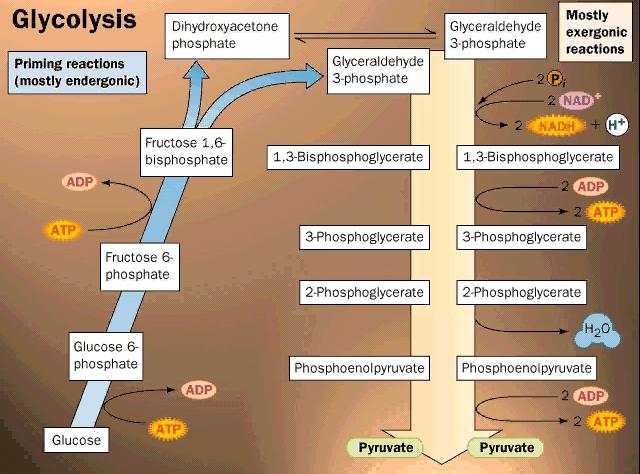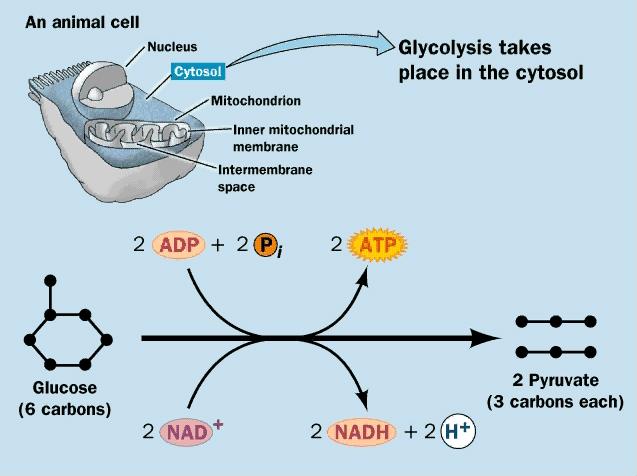.jpg)
Glycolysis is the reaction that converts each glucose molecule
into two pyruvates to be later used in the following steps of cell respiration. As you can see in the image glycolysis goes through a variety of steps before
it is able to reach it's final result of two pyruvates. With the aid of ATP,
the glucose molecule is first turned into a glucose 6-phosphate. then it continues
to be changed itnto fructose 6-phosphate. Once again, with the use of ATP,
it is then changed into fructose 1, 6-biphosphate. Then each of these is converted
into a dihydroaxyacetone phosphate and into a glyceraldehyde 3-phosphate.
Upto here all the reactions have been mainly endergonic. These reactions
are represented in the diagram on the left side, shown with the upward, thin,
blue arrow. Later, the two glyceraldehyde 3-phosphate molecules go through
a series of reactions that modify them and finally end up as pyruvates. Meanwhile
the middle steps have come to produce a NADH + a H ion, in the first step,
2 ATP's in the second step, a water molecule in the fourth step, and finally
another two ATP's in the fifth step. All the steps involved in transforming
Grlyceraldehyde 3-phosphate into pyruvate are all exergonic. They are
represented on the diagram as the downward, thin, cream arrow.
As you can see in the image glycolysis goes through a variety of steps before
it is able to reach it's final result of two pyruvates. With the aid of ATP,
the glucose molecule is first turned into a glucose 6-phosphate. then it continues
to be changed itnto fructose 6-phosphate. Once again, with the use of ATP,
it is then changed into fructose 1, 6-biphosphate. Then each of these is converted
into a dihydroaxyacetone phosphate and into a glyceraldehyde 3-phosphate.
Upto here all the reactions have been mainly endergonic. These reactions
are represented in the diagram on the left side, shown with the upward, thin,
blue arrow. Later, the two glyceraldehyde 3-phosphate molecules go through
a series of reactions that modify them and finally end up as pyruvates. Meanwhile
the middle steps have come to produce a NADH + a H ion, in the first step,
2 ATP's in the second step, a water molecule in the fourth step, and finally
another two ATP's in the fifth step. All the steps involved in transforming
Grlyceraldehyde 3-phosphate into pyruvate are all exergonic. They are
represented on the diagram as the downward, thin, cream arrow.
This process is the first step in both aerobic and anaerobic respiration. Although it uses up two ATP molecules in the endergonic half of the process, it also creates four ATP molecules in the exergonic half. Therefore, there is a net production of two ATP molecules throughout glycolysis.
 In
the case of both animal and plant cells, glycolysis takes place exclusively
in the cytosol. The key to glycolysis is that it produces TWO pyruvate
molecules for every glucose molecule that it starts with. This is because
it converts the 6-carbon glucose into TWO 3-carbon molecules, being
pyruvate. This is shown on the bottom half of the picture to the left.
In
the case of both animal and plant cells, glycolysis takes place exclusively
in the cytosol. The key to glycolysis is that it produces TWO pyruvate
molecules for every glucose molecule that it starts with. This is because
it converts the 6-carbon glucose into TWO 3-carbon molecules, being
pyruvate. This is shown on the bottom half of the picture to the left.